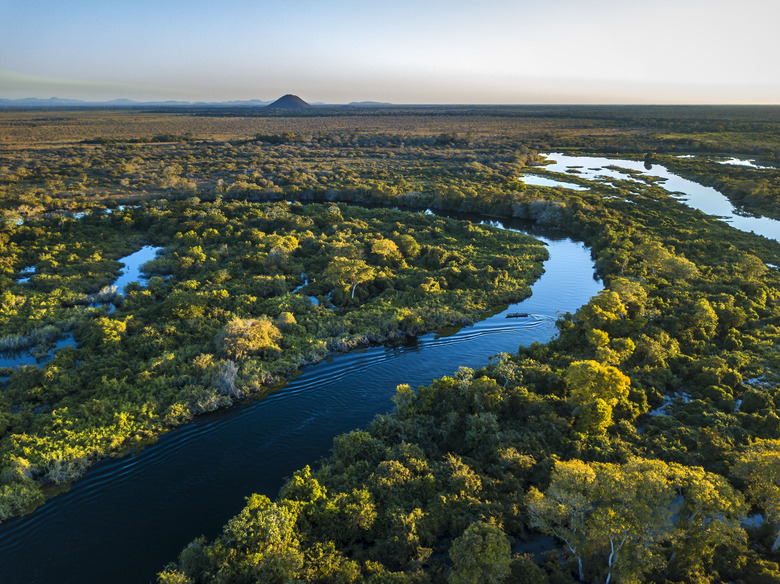The Differences Between Biomes & Ecosystems
The difference between biome and ecosystem has to do with their root definitions and what they describe. A biome is a large region of the world that has similar plants, animals and other organisms that are adapted to the terrain and weather of that region. An ecosystem is the interaction of plants and animals with nonliving things and each other. Each organism has a role to play within the ecosystem.
Ecosystem and Biome Definition
Ecosystem and Biome Definition
According to National Geographic, the biome definition is an area on the planet that is classified by the animals and plants in that area.
An ecosystem, on the other hand, is defined as a biological community of interactions between all living (biotic) and nonliving (abiotic) things in a particular area.
The difference between biome and ecosystem lies with their definitions. A biome is simply a classification of an area based on the things within it. The species that live there are determined by temperature, geographic location, climate and more. An ecosystem, on the other hand, refers to the actual interactions, relationships, communities and populations of organisms and nonliving things within biomes.
You can think of a biome as a broad classification of an area while an ecosystem refers to interactions and specifics within that general classification. You can actually have multiple ecosystems within a single biome. For example, one type of biome is a marine biome. Within that biome you can have many ecosystems like a coral reef, the intertidal zone, a kelp forest and the open ocean.
Biomes of the World
Biomes of the World
All of the biomes of the world fall into this list:
- Aquatic biomes
- Alpine and Arctic tundra biomes
- Rainforest biomes
- Temperate forest biomes
- Desert biomes
- Grassland biomes
Biomes can border each other and are usually determined by geological terrain and weather. Species that live in these border areas can cross between two biomes and can have a dual role to play in each biome. Several ecosystems, which are smaller than biomes, can exist within a biome and many species can exist within different ecosystems. Biomes occur naturally but artificial biomes can be created by humans.
Ecosystems
Ecosystems
Within ecosystems, habitats exist that vary in size. Habitats are defined as the areas populations of organisms live in. A population is a group of organisms that live in the same place at the same time. Different populations interact, and when they interact, they are considered a community.
Ecosystems are defined as when these communities interact with their nonliving environment. The habitat provides food, water and shelter for the organisms that live within it and when those supplies become diminished, the organisms will move to another habitat.
Ecosystem vs Biome Destruction
Ecosystem vs Biome Destruction
Destruction and change of our world doesn't care whether it affects an ecosystem vs biome. In fact, when there is a depletion of resources, climate change or other damage, both biomes and the ecosystems that exist in it can be damaged or completely destroyed. The depletion in one biome can affect another biome and then affect all ecosystems within those biomes.
For example, in the forest biome, deforestation not only destroys the ecosystem and habitats within the forest biome, but the lack of trees can affect neighboring biomes. Trees redirect and shield wind and weather. Without trees erosion takes place and weather changes occur, which can affect climate in other biomes and ecosystems.
Organisms in those ecosystems can lose resources. They'll then have to find different habitats or increase competition for the remaining resources. If they can exist in another biome, organisms will invade the new biome creating new ecosystems or destroying existing ones.
Organisms Sharing Two Biomes or Ecosystems
Organisms Sharing Two Biomes or Ecosystems
Sometimes organisms share two or more biomes or ecosystems. For example, when the desert biome meets the ocean biome, predators from the desert, like foxes or coyotes, will sometimes prey on fish or other sea life in the ocean biome. Though the mammals do not live within the ocean biome, they reduce the population of that biome, which could affect the relationships between the organisms that live in the ocean biome.
A sharp increase in land mammals that prey in the ocean biomes could destroy the balance and, in the end, destroy entire populations. The resource would be depleted and the land mammals would move to another habitat where they could survive, which would also cause the food chain/web to shift in those areas.
Cite This Article
MLA
Rainwater, Don. "The Differences Between Biomes & Ecosystems" sciencing.com, https://www.sciencing.com/differences-between-biomes-ecosystems-8163420/. 22 November 2019.
APA
Rainwater, Don. (2019, November 22). The Differences Between Biomes & Ecosystems. sciencing.com. Retrieved from https://www.sciencing.com/differences-between-biomes-ecosystems-8163420/
Chicago
Rainwater, Don. The Differences Between Biomes & Ecosystems last modified August 30, 2022. https://www.sciencing.com/differences-between-biomes-ecosystems-8163420/
